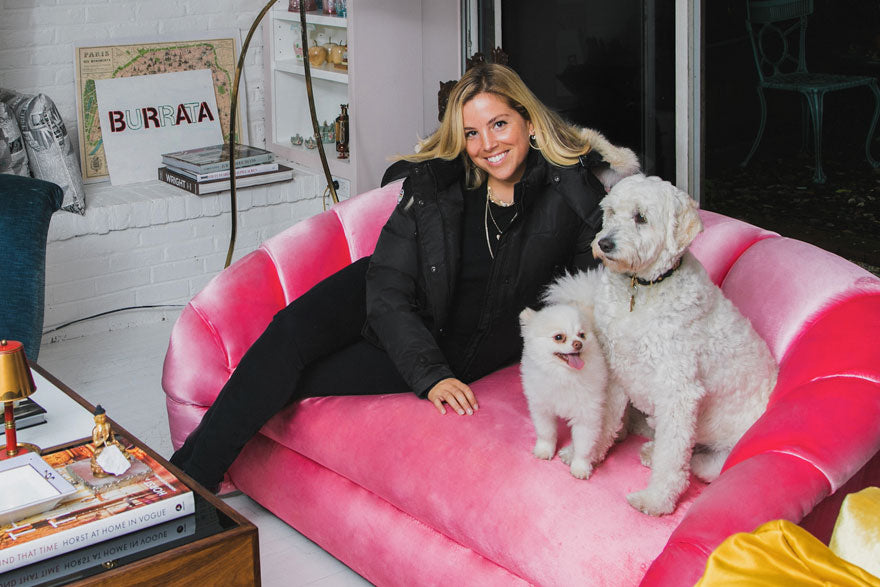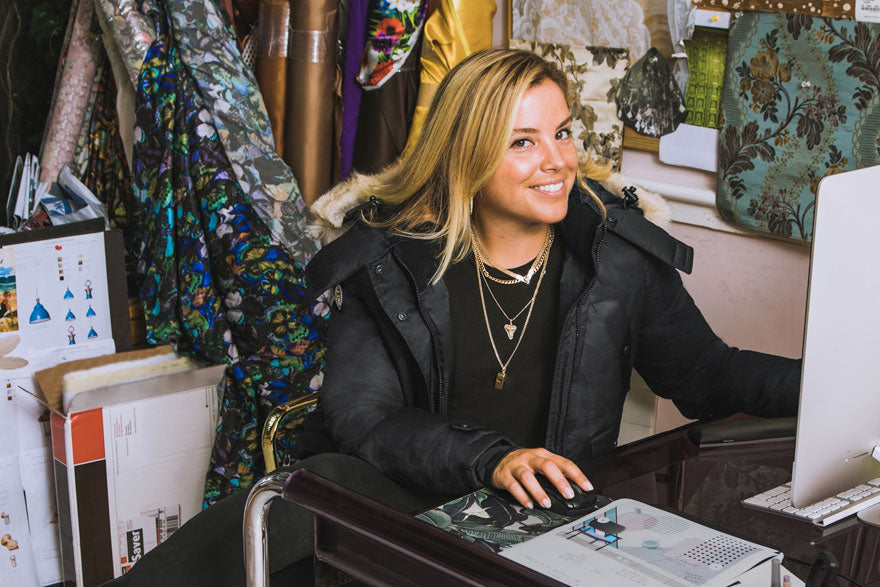A few years ago, interior designer Sasha Bikoff, still only in her mid-twenties, burst on the scene with the interiors she created for her mom and others in the storied Dakota building, including one apartment that was lauded for its interior design inspiration that is “equal parts Scarface and French midcentury.”
Since then, her ability to combine seemingly incongruous patterns, colors, eras and designs into eclectic and vibrant décor has made Bikoff sought-after by high-profile clients, and has her expanding her burgeoning design empire into a line of rugs, furniture, candles, fabric and even clothes. There’s also a possibility of her opening a design emporium complete with a café to house all of her business ventures.
Having grown up in New York City, studied fine arts and art history at George Washington University and the American University in Paris, and extensively traveled abroad, Bikoff has cultivated far-reaching and diverse passions and inspirations from which she derives ideas and motivation for her work.
“My goal is to teach about a new design style that references the past with usage in the present,” she says. “I want to bring new ideas and design to the table that will inspire people and ignite a sense of creativity.” Here she tells you how to ignite your own senses of creativity to bring your interests and passions into your favorites spaces.

BRAINSTORM FROM THE START
“I am greatly inspired by my clients, their dreams and inspirations which I infuse into my spaces so that everyone has a unique home and personal experience,” Bikoff says (seen here wearing the Triple F.A.T. Goose Norden in black).
To do that, she interviews each client, finding out what they do, how they spend their downtime, where they go on vacation and what their hobbies are. Taking what she’s learned, Bikoff then conceptualizes elements of the design that will fit her client’s life and lifestyle—often uncovering what the client truly wants without the client originally knowing exactly what that was.
“I put my ideas for fabrics, furniture, lighting, etc. down on a mood board in order to organize my thoughts,” she notes. “I do it the old way with scissors, thumbtacks and paper.” For those looking to catalog their interior design inspiration on the computer, there are all kinds of mood board makers that allow you to cut, paste and share an array of images, products and ideas meant to inspire creativity and help organize ideas.
And not all these ideas have to come from your own experiences. In fact, Bikoff says it’s great to branch out into the unknown. “With Instagram, art, magazines, blogs and movies, you can visit many places from where inspiration can come,” she says. She also adds that bringing in newer elements that are designed to create an environment in which you feel comfortable can actually inspire you get out of your comfort zone.
“You don’t need to visit a place to fall in love with it,” Bikoff counsels. “If you decorate your home with references to Paris and haven’t been there, you are putting that energy out into the universe that you want to go there, and maybe one day that dream will become a reality. That’s a positive message for your home!”

GO PERSONAL NOT UNIVERSAL
“My personal references are universal in the sense that they come from design history,” Bikoff says. “But I don't really care to reference elements that are more universal because those are already done and, at this point, basic.”
That means when you’re in a furniture showroom and the salesperson pushes buying a collection in which every piece matches and looks exactly the same, walk away as fast as you can. Instead, find elements that speak to you as an individual.
“It’s very easy to apply personal interest and pieces into a space,” Bikoff states. “In fact, it’s necessary to create a personalized unique experience.” Take those side tables that you love and bought on a trip to Morocco, she says. “If traveling is a passion of yours, you can find a place for them,” she says, even if your house isn’t completely outfitted in Moroccan décor.
“Use the side tables and connect them with another piece in your home through color or material,” she recommends. “Maybe the side tables are made of pierced brass. So a good idea would be to incorporate brass in another piece nearby, like the legs of a dining table.”
Now the Moroccan tables still stand out as being unique to you and your story, but they also coordinate with the rest of room’s décor. Or as Bikoff assures, “It’s all about connecting the dots and letting your eye wander from piece to piece.”

READ THE ROOM
“It’s very important to take into account where you are decorating,” Bikoff states. That means that before you start bringing in your ideas for interior design inspiration as well as your personal pieces, you have to read the room. A modern set up is going to have a certain vibe that’s different from a vintage structure or a rustic building.
“Initially I look at a space as though it were a blank canvas.” Bikoff says. “I walk into a space and observe the architectural details, the surroundings, where we are and what kind of house or building it is, and connect it with a theme.”
From there she tackles the structural elements of the space. “I start working on what I call the canvas—the walls, floors and ceiling,” she says. “I choose paint, wallpapers, carpets, and then I build up on that as if you were building up paint and subject matter in a painting.”
And it’s not just the interior of a room or building that can influence its design. What’s outside can play an important part—whether it’s the exact location or another spot that’s brought in as an influence.
“I had a client from Palm Beach and one from Charleston, South Carolina that wanted their NYC pads to look like these places,” Bikoff remembers. “It’s a fun idea, and there are ways to incorporate the elements and motifs of two places into a one space by mixing both elements so that it doesn’t look out of context.”
GET BOTH FUNCTION AND FORM
“There should be a balance of style and function,” Bikoff advises. The equilibrium between the two qualities can shift depending on the person, Bikoff concedes, as “for some people comfort and function is a top priority, but you never want to jeopardize one for the other.”
That means if you are going to be sitting in it all day maybe rethink that hard, angular Lucite chair, but if you truly want to make an effort in terms of creating a space with a wow-factor than forgo that ratty old armchair as well.
A good example of finding balance is one of Bikoff’s favorite—an 18th century French vanity in her bedroom. She loves it for its antique design and unique styling, but also because it is useful—an inspiring and personal space where she gets ready for the day.

MIX WITHOUT GETTING MIXED UP
A lot of people love bright or more distinct colors but when you look at their homes, they are very drab or one-note because they fear having more than one hue, thinking it will create a clash of colors.
But Bikoff says this isn’t the case if you do it right. “Look to nature as inspiration,” she advises. “I tell people to look out onto a field—the sky is blue with clouds, the grass is green, the flowers are bright red. All those colors look great together and so too does this work in the comfort of your own home.”
A self professed maximalist who loves everything from ‘80s glamour and 1960s space age to 18th century French Rococo, Bikoff says the same approach to mixing color applies to the age and style of the furniture, and the design elements you bring into a space.
“Mixing antiques and vintage items with contemporary or custom furniture is a very modern idea,” she explains. “For every antique or vintage theme you use, pair it with something new and it will give the older piece a new life and the newer piece a sense of richness.
Plus, combining new and old means you’ll have more to play with when it comes to cultivating interior design inspirations, and your space will never become dated after you’ve finished. “It’s all in the mix!” she professes. “Mixing design pieces from different eras and places keeps things exciting and alive.”
And, in the end, feeling alive is what it’s all about. Because by working Bikoff’s advice into your décor, you will create unique and personal spaces that feel like home, but still excites and inspires you to leave the house and experience the wonders of the outside world.

